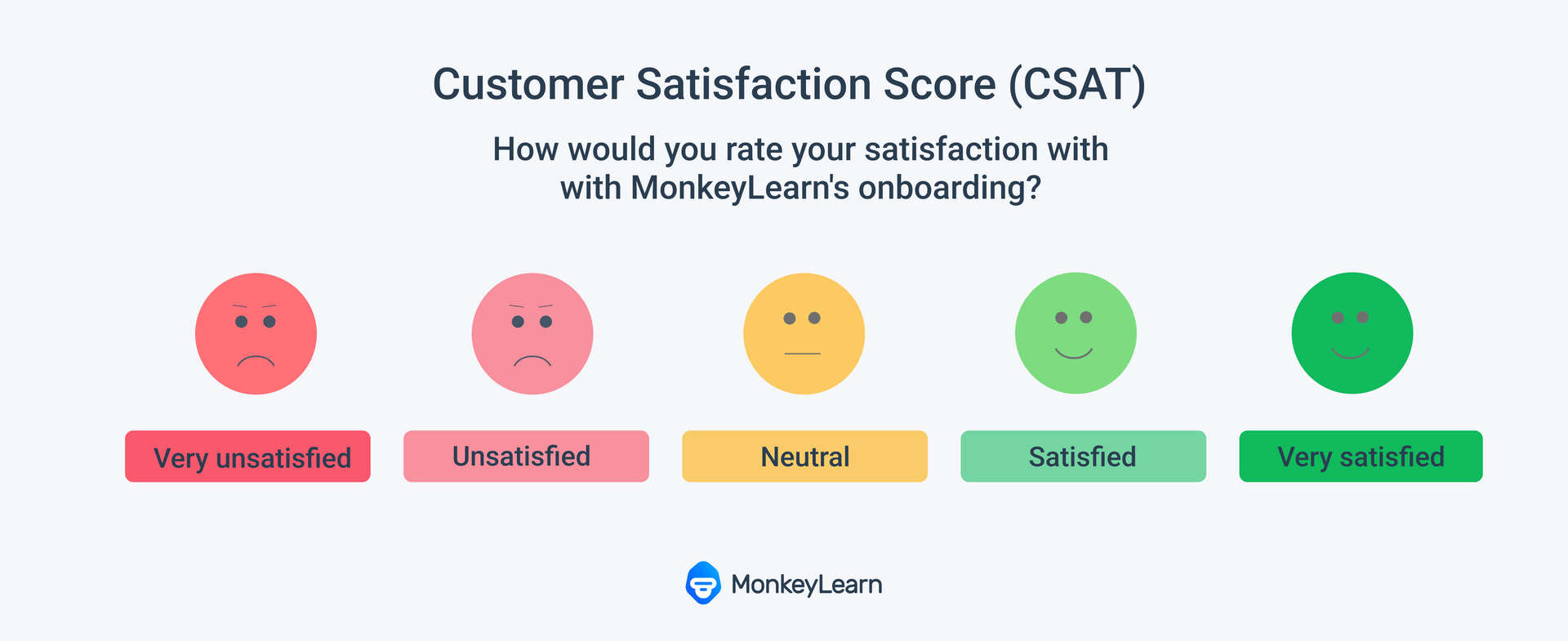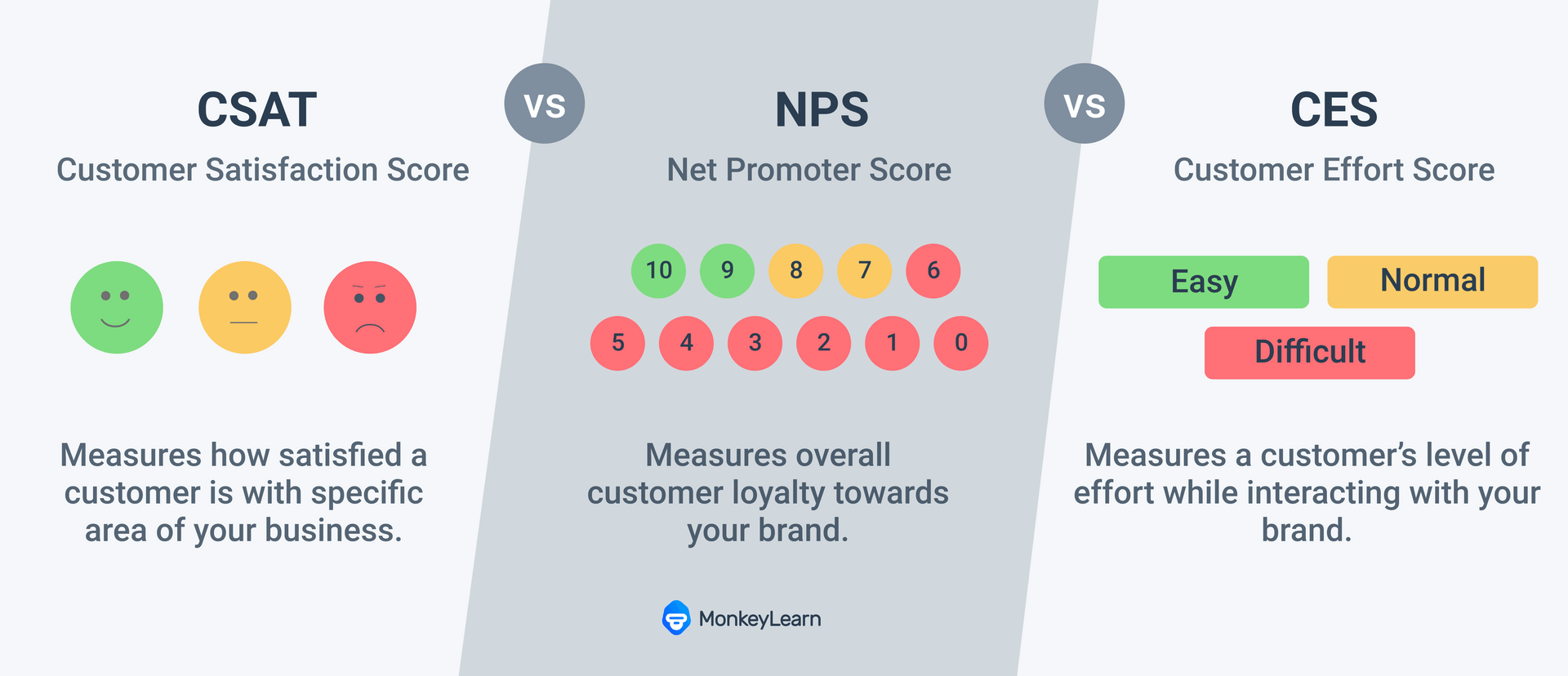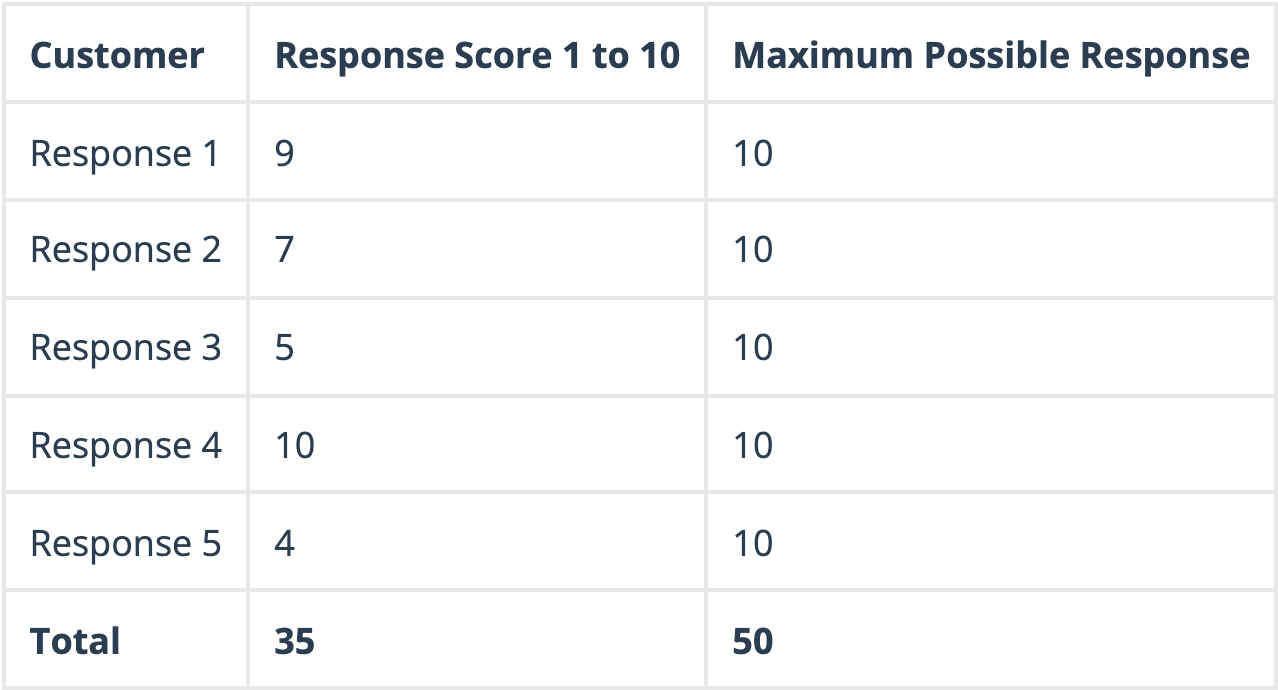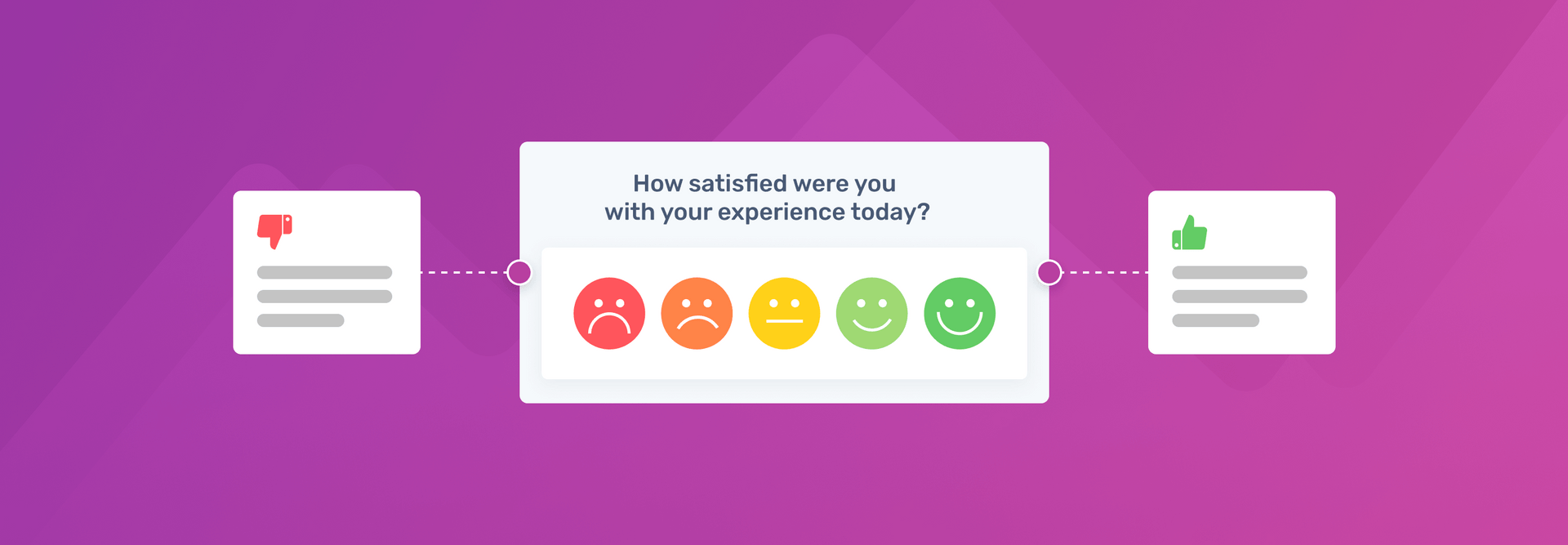CSAT Guide: What Is Customer Satisfaction Score?

Satisfied customers are the bedrock of a successful business.
You can have a number of ambitious business goals, but if you don't keep on top of customer satisfaction, your efforts will be in vain.
High customer satisfaction levels lead to increased customer loyalty, and it's the loyal customers who are your ticket to long term business growth.
Unsatisfied customers on the other hand, can lead to a drop in sales and customer churn.
Therefore, monitoring customer satisfaction levels, finding out why your customers feel like they do, and putting solutions in place, is essential for the health of your business.
To keep track of your customer satisfaction levels you'll need to make use of the customer satisfaction score (CSAT) -- a simple metric that monitors how happy, or unhappy, your customers are.
Need to get you up to speed on all things CSAT? By the end of this guide, you'll be ready to set up a successful CSAT campaign.
Perhaps you're further along your CSAT journey. Jump to the section that's most relevant to you.
- What Is CSAT?
- CSAT Survey Questions
- When To Use CSAT
- CSAT Pros & Cons
- CSAT Examples
- Analyzing Your CSAT Results
- The Wrap Up
What Is CSAT?

The CSAT or customer satisfaction score is a metric which represents how satisfied or dissatisfied your customers are with your products, services, and in their interactions with representatives from your company.
It is a good way to track the performance of both your teams, and your products and services to see where you need to improve. It's also one of the easier ways you can tap into how a customer is feeling.
Your CSAT score is obtained via a simple survey. This survey can include a number of questions, however it's most effective when it's short and to the point.
CSAT Survey Questions
What is always present in a CSAT survey is at least one close-ended question. The following question is characteristic of the CSAT:
How would you rate your satisfaction with (our company, product, customer service, etc.)?

Here are some examples of how you could vary this question to tailor it to a particular need, and get more targeted responses:
- What did you think of [a particular feature]?
- How would you rate your satisfaction with how we resolved your query today?
Customers can answer these questions on a likert scale of 0-5 or 0-10, with levels of satisfaction ranging from 'very unsatisfied' to 'very satisfied'.
This initial question will only give you quantitative data, so it's good practice to follow it up with an open-ended question like, What could we have improved on today? This allows your customer to expand on why they chose the score they did.
In doing this, you get more information from which you can pull insights.
Discover how to get detailed insights from open-ended CSAT responses.
These insights show you what kind of changes or improvements you should make to your products and services to enhance the overall customer experience (CX).
Why Keep Track of Customer Satisfaction?
50% of customers will switch to a competitor after one bad experience. In the case of more than one bad experience, that number snowballs to 80%. (Source: Zendesk)
Offering a great customer experience is the name of the game, and improving it is just one of the benefits you'll gain from tracking your customer satisfaction levels.
Here we'll dive into how CSAT can help you improve your customer experience, as well as some other important benefits of tracking your CSAT:
1. Improve Your Customer Experience
By tracking your customers' satisfaction levels, you can identify the things that are making them unhappy in their customer experience journey.
According to one study, 86% of buyers said they would pay more for a great customer experience. This means it's important to check in regularly to see if you are meeting your customers expectations, and if not, to put measures in place to improve their experience.
2. Make Your Customers Feel Heard
When customers feel like you are listening to them and care about their frustrations, their trust in your organization will increase and they will be more likely to recommend you to their contacts and keep doing business with you.
3. Improve Products and Services
Your CSAT survey results can reveal product issues or flaws. This is good news because you can then go in and correct these issues before they impact more customers.
The results may even reveal that a product or feature is missing for your customer. The feedback you get from a CSAT survey allows you to shape your products and services so they are more aligned with your customers' needs.
4. Monitor Satisfaction and Brand Perception Over Time
When you consistently send out customer satisfaction surveys after specific touchpoints, you can track changes to customer satisfaction levels. This helps you to see what is it that you are doing that is working and what is not. It also shows you what your customers think of your brand.
5. Increase Customer Loyalty
Customer satisfaction correlates closely to loyalty. When your customers are loyal, they're more likely to keep doing business with you and recommend that others do too. Therefore, keeping your customers satisfied reduces your risk of customer churn and increases your profits.
Customer Satisfaction Surveys Compared
CSAT is not the only metric you can use to measure customer happiness. In fact, you should be using a variety of metrics to get a more accurate, well-rounded idea of your customers' satisfaction levels.
The CSAT is most effective when used alongside other customer satisfaction survey metrics like the Net Promoter Score (NPS) and the Customer Effort Score (CES).
Let's take a look at how these different metrics stack up against each other.

Net Promoter Score (NPS)
The Net Promoter Score (NPS) was designed to measure customers' loyalty and how likely they'd be to recommend your products and services. It follows the same format as a CSAT survey, but varies in the type of close-ended question asked:
On a scale of 0-10, how likely would you be to recommend this service/product/company to a friend?
In this format the NPS is used to assess overall customer loyalty. However the question can be tweaked slightly to hone in on specific areas of the customer experience:
On a scale of 0-10, how likely would you be to recommend this service/product/company to a friend based on your recent interaction?
Those who give you the highest scores are labeled as Promoters and those who give you the lowest scores, Detractors. To get your NPS score you just detract your number of Detractors from your number of Promoters.
See more information on how to calculate your NPS.
The Net Promoter Score can be used to drill down into specifics or to get an overall idea of how your customer feels, however it's strength is looking at the bigger picture. The CSAT is a much stronger metric if you want to measure satisfaction in the moment.
Learn more about the differences between CSAT and NPS.
Customer Effort Score (CES)
The Customer Effort Score survey measures your customers' perception of how easy it is to do business with you. This is an important question as customer effort has been found to correlate closely with loyalty.
The customer effort score question is:
How easy was it to solve your problem today?
Your customer then answers from a scale and you can calculate your score by adding the total of the responses and dividing that by the number of responses received.
The customer effort score is best when it is sent immediately following (and is specific to) an interaction or touchpoint.
How to Calculate Your CSAT Score
When you give your customers the choice of responding on a scale of 0-5, calculating your CSAT Score is relatively straightforward. You just divide your positive scores (the total number of 4 and 5 scores) by the total number of customers surveyed, then multiply that by 100.
Let's take a look at an example:
If 100 people took your survey, and 75 gave you either a 4 or 5 out of 5, your score would be 75.
CSAT Score: (75/100) x 100 = 75

Here are some more examples using different scales: If you are using a scale of 0-10, you'll need to add up all the scores you were given, divide that by the maximum number of possible scores you could have received and multiply it by 100.
Here's what this calculation would look like if you asked 5 customers to rate the customer service they had just received on a scale of 0-10:

If you are using a yes/no question your calculation will be slightly different. Imagine you ask the question: "Did we help you with everything you needed today?" after a customer service call with 200 customers. If 140 respond yes and 60 no, your score is 70%.
If you are using emojis or words like very unsatisfied to very satisfied, you can attach a numeric value to each possible answer then calculate it using one of the above CSAT formulas.
Alternatively, use this handy CSAT calculator.
What is a Good CSAT Score?
There is no universally agreed standard on what is a good score as it changes across industries, some with higher averages and some with lower averages than others, i.e. internet service providers.
Generally speaking however, a CSAT score of 75% or more is considered good and 80% or more is considered the gold standard. 75% or more means that at least 4 out of 5 customers have given you a good score.
Below you'll find a list of industries and average CSAT scores. You can also check the ACSI (American Customer Service Index) to see how these industry averages change overtime.
Benchmarking against your own score over time is also a solid way to measure your progress and to see whether your initiatives are improving your score or not.

When To Use CSAT
The CSAT is great for capturing a customer's feelings about a specific point in their customer journey. Here are a few instances where you can put the CSAT to use:
- Following an interaction with a customer service agent: By following up quickly, your customer's experience will be fresh in their mind and they'll be more likely to answer honestly. Post-phone call automated surveys are a good example of this.
- While your customers are using a product: Another time you can send a CSAT is when your customers are actually using a product. This could mean setting up an in-app pop up survey or a pop up on your website.
- Following a new purchase or download: You can send out a CSAT a few days after your customer has purchased or downloaded your product or service asking them how they're doing. You could also send one before your customer is due to renew a service or subscription.
- Following an important touchpoint or milestone: This could be following on from a purchase, a delivery, an experience, a stay, or any touchpoint you deem important. By focusing on a particular instance, you can isolate specific parts of the customer experience to see exactly where any pain points are.
Frequency is something that you should think carefully about. You need to be able to gauge whether your changes are having an impact, and you need to be able to see if satisfaction levels are changing.
But, you have to be careful not to send too many surveys. When you do this you risk annoying your customer and them not completing the survey.
CSAT Pros & Cons

The CSAT is a simple and useful metric, so naturally it has a lot of pros. It does, however, have some cons. We'll go through both the good and the bad here:
CSAT Pros
Easy To complete
Seeing as a CSAT survey is just one or two questions, it's easy for your customers to finish and there is less risk of survey fatigue hitting and them not finishing.
Easy To Calculate Your Score
The CSAT comes with a simple equation which makes tallying up a large amount of scores relatively easy. The tricky part can come when you are analyzing the qualitative data, but we'll get to that soon.
It's Flexible
You can adapt the classic CSAT question to ask about a wide range of areas of your business, from interactions with your customer service team, to products, and everything in between.
Makes Continuous Improvement More Simple
You can easily benchmark your score against previous scores. This allows you to measure the impact of enhancements, new features, or new products, and to steer future improvements.
CSAT Cons
Satisfaction Can Be subjective
Not everyone holds the same definition of subjective and what makes one person satisfied might not do it for someone else. This makes it hard to take the results 100% at face value.
There Is No Overall Perfect Score
Seeing as scores vary from industry to industry, and can also vary according to country and culture, it's hard to benchmark against other organizations or define a perfect score.
It's an In-the-Moment Metric
While in theory you could send it at any time, it works best when sent promptly following an interaction. Therefore while it can give you great, in the moment insights, it's not great at giving you an overall look at your customers sentiment.
Cultural Bias
The customers' country or cultural background can also impact their answers. For example, people from Latin America tend to rate their satisfaction higher than other countries, whereas in Japan they tend to rate their satisfaction lower.
Response Bias
Response bias is also at play here. This means that many external factors can impact the customers' score. This could be the time of day that they fill out the survey, the weather, an unrelated negative encounter they've had directly before completing the survey... the list goes on.
CSAT Examples in Practice

Now we've covered the theory, let's go through some examples of CSAT surveys so you can get an idea of what they look like in practice.
Apple - the matrix CSAT
Apple is famous for its consistently high levels of customer satisfaction. This is connected to the fact that they often ask their customers how satisfied they are with their interactions.
Below you can see an example of a matrix CSAT survey that has been deployed directly following the delivery of an order. It asks the customers to answer 5 different questions all related to their satisfaction levels around the delivery.
With this information Apple can isolate various different aspects of the delivery process to see where any issues might be arising.

Youtube - seamless integrated CSAT
What stands out about this example is the delivery. Youtube delivers their CSAT survey in a format that makes sense and that makes it easier for their customers to respond.
Their surveys come in the format of an advert that the customer sees before they see their next video. As their customer is in the app or website already, their experience and satisfaction is likely to be fresh in their minds. As they are already right there, they don't have to take any additional action to respond, so it's more likely they will.

Amazon - simple & personalized CSAT
Amazon places a lot of stock in customer satisfaction levels. This is because they know that the more satisfied customers they have, the more sales they will make. They consistently send out CSAT surveys following on from sales and deliveries.
As you can see in the example below, they choose a survey that is simple and easy to complete. The fact that the customer doesn't have to use a lot of effort makes them more likely to complete it and for Amazon to get more insights.

Analyzing Your CSAT Results

The strength of the CSAT and the tangible benefits it brings your business will ultimately depend on how you analyze your results. This is because just knowing your CSAT score is not enough to improve on it. You have to know what is causing any lack of satisfaction to be able to put corrective measures in place.
As we touched on, this useful, actionable information can be found in an additional open-ended question. By adding this second question directly after the classic closed-ended question your customers can elaborate on what is impacting their satisfaction levels and you can use these insights to make changes that will enhance your customer experience.
However, to get to these insights, you'll first need to perform qualitative CSAT analysis. Manual analysis of survey results is inefficient and sometimes impossible. So to do it properly, you'll need to employ the right tools to help you automate.
Text analysis tools like MonkeyLearn, make analyzing your CSAT survey data easy.
Using powerful machine learning techniques like sentiment analysis and keyword extraction, MonkeyLearn helps you analyze your data and get insights in seconds. It also comes with data visualization capabilities and an interactive, easy to use dashboard where you can filter your insights by topic, sentiment, keyword, and more.
Take a look at this CSAT dashboard:

Want to discover how to perform CSAT analysis on your open-ended responses? Book a demo with MonkeyLearn.
The Wrap Up
The more satisfied customers you have, the more likely you are to increase your sales and grow your business. If you have unsatisfied customers, you need to get to the root of the problem to fix it.
In order to correct any customer satisfaction issues you first need to know what is going on, and ask what your customers need and expect from you.
The CSAT is a simple yet powerful metric that helps you keep track of how happy your customers are in their interactions with your company. The survey gives you feedback which, with the right survey analysis tools, you can then use to enhance your products and services, and your overall customer experience.
Start a free trial today to see how you can transform your CSAT survey data into actionable insights that lead to growth.


